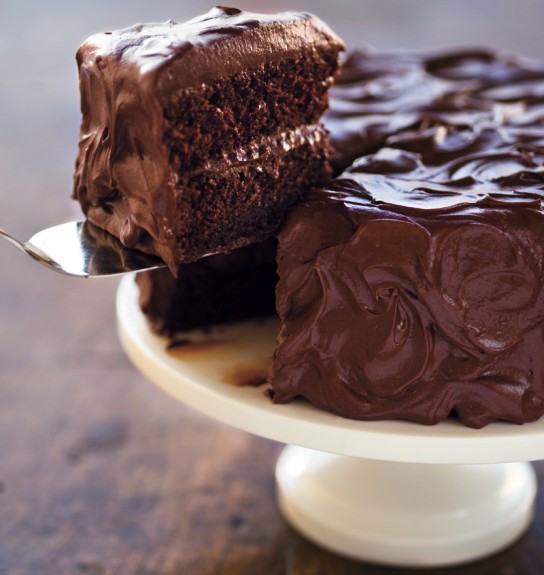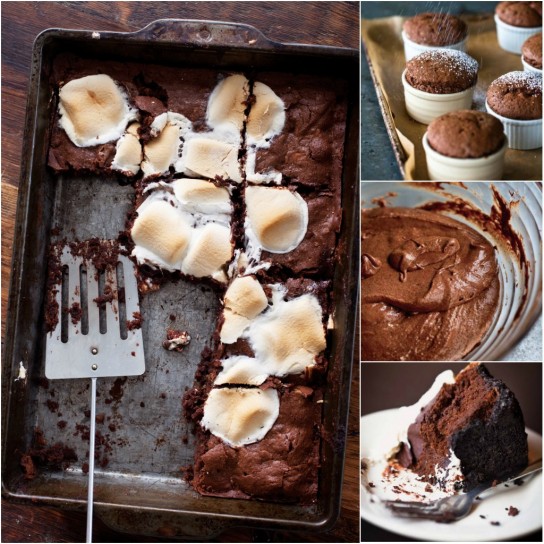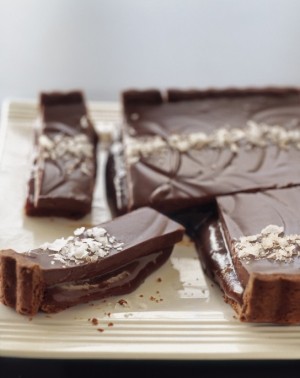Any chocolate lover knows how the luscious, beloved treat gives a true sense of well-being and satisfaction. Maybe that’s why everyone fought over chocolate centuries ago. These days, we’re lucky to be surrounded by an abundance of scrumptious chocolate. It truly does make a difference in the finished cake or pudding if you use a high-quality brand of chocolate or cocoa; no matter what you’re making, buy the best you can find.
HOW IT’S MADE
Chocolate is made by fermenting, roasting, shelling, then crushing cocoa beans to produce “nibs,” which are about 50% cocoa butter. The nibs are ground and pressed into a paste called chocolate liquor, which forms the basis for all kinds of chocolate.
STYLES
- Milk: A mixture of chocolate liquor, sugar and milk solids. It has a creamier flavor than bittersweet or semisweet chocolate. Look for a “darker” version around 40% cacao. Keep in mind that European chocolate are usually less sweet and have a deeper, more refined flavor than American-made chocolates.
- Bittersweet or semisweet: With 60-75% cacao solids, this “dark” chocolate is richer than milk chocolate. It’s ideal for baking, because it’s not too sweet and rich.
- Unsweetened chocolate: Pure chocolate liquor, also known as baking chocolate. In its pure form it contains no sugar, but depending on the amount of sugar added, the liquor becomes bittersweet or semisweet chocolate.
- White chocolate: Made from cocoa butter, sugar and milk solids. It is actually not considered chocolate at all, because it lacks the key defining element: chocolate liquor.
- Cocoa nibs: Roasted and ground cacao kernels. They give fillings, cookies brownies and other baked goods a chocolatey crunch and are delicious sprinkled over ice cream and frosted cakes.
- Cocoa powder: Extracted solids from the cocoa bean. Use a natural, unsweetened, high-quality brand. The powder should be a rich, dark brown, not gray or light in color. Dutch-process cocoa is treated with an alkali and is darker, less acidic, and milder in flavor. Don’t swap it for regular cocoa powder in recipes that rely on baking soda for leavening (Dutch-process cocoa can’t activate the baking soda the same way the natural kind can).
Store chocolate in a cool, dry place away from light and odors. You can wrap it in aluminum foil as another layer of protection. Never store it in your refrigerator or freezer.
If it turns whitish and cloudy, don’t worry — called “bloom,” this discoloration occurs when chocolate has been stored in an environment that’s humid or too warm, causing the cocoa butter to separate. The bloom will go away when the chocolate is melted.
WORKING WITH CHOCOLATE
To melt chocolate: Chop the chocolate and place it in the top pan of a double boiler, or in a heatproof bowl that will fit snugly in the rim of a heavy saucepan. Fill the bottom pan of the double boiler or the saucepan with water to a depth of about 1 1/2 inches (4 cm.) and heat over low heat until it barely simmers. Place the top pan or bowl holding the chocolate over (not touching) the water in the lower pan. Heat, stirring often, until the chocolate melts. Remove the top pan from over the water and set aside to cool slightly before using.
To make chocolate curls: Slightly soften a chunk of chocolate in the microwave on medium (50% power). For curls, using a vegetable peeler, scrape the blade lengthwise across the softened chocolate to create pretty, delicate curls. Refrigerate the curls until ready to use. Use them to decorate a cake or another chocolate dessert.
To make chocolate ganache: Chop 8 oz. (250 g.) semisweet or bittersweet chocolate into even pieces. In a heavy saucepan over medium-low heat, combine 2/3 cup (5 fl. oz./160 ml.) heavy cream and 2 Tbs. unsalted butter until melted. The mixture should register about 160 degrees F.
Remove the pan from the heat and add the chopped chocolate, letting it sit in the hot cream for about 30 seconds to soften. Add 1 tsp. pure vanilla extract and, using a whisk, stir the mixture until all the chocolate is melted and the mixture is smooth. Use right away as a sauce for ice cream, a shiny glaze for a cake, or a filling for a tart. Or, let cool for 1-2 hours at room temperature for a thicker fudge filling.

RECIPES
See some of our best recipes starring chocolate in all its delicious forms:
- Chocolate Ice Cream
- French Chocolate Macarons
- Chocolate Soufflé
- Chocolate Caramel Tart
- Chocolate Pots de Crème
- Chocolate Truffles
- Chewy Chocolate Meringues
- Devil’s Food Layer Cake
- S’mores Brownies



1 comment
[…] Ingredient Spotlight: Chocolate […]